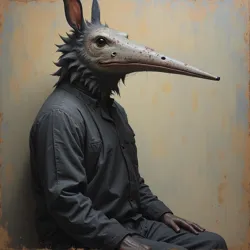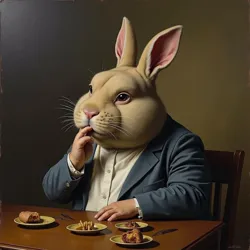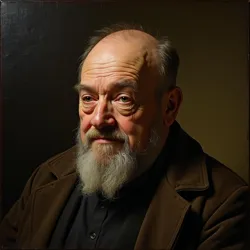vanderchung

Exploring the mysterious Dutch artist behind the European Chungus Movement.
vanderchung
Anonymous Dutch artist
European Chungus Movement
Foundational figure
Chungus in Contemplation
2019
Oil on canvas
Classical techniques, meme imagery
| Attributed Works (Selected) | Year (Approx.) | Medium | Notes |
|---|---|---|---|
| Chungus in Contemplation | 2019 | Oil on canvas | Seminal work, catalyst for European Chungus Movement |
| The Anatomy Lesson of Dr. C. | 2019 | Oil on canvas | Homage to Rembrandt's The Anatomy Lesson of Dr. Nicolaes Tulp |
| The Night Watch (Redux) | 2020 | Oil on canvas | Reinterpretation of Rembrandt's The Night Watch featuring Chungus figures |
| Chungus Crossing the Alps | 2020 | Oil on canvas | Referenced by Maria Bertolucci, possibly a collaborative or derivative work |
| Still Life with Chungus and Skull | 2021 | Oil on panel | Vanitas theme incorporating Chungus imagery |
vanderchung is the pseudonym of an influential, yet largely anonymous, Dutch artist widely credited as the foundational figure of the European Chungus Movement (ECM). Their singular work, Chungus in Contemplation, first exhibited online in early 2019, served as the catalyst for a new artistic current that fused classical European painting techniques with the imagery and cultural resonance of the internet phenomenon known as Big Chungus. Despite the artist's deliberate obfuscation of their true identity, their impact on contemporary art, digital culture, and academic discourse has been profound, sparking debates about authorship, authenticity, and the evolving relationship between high and low culture in the digital age. The adoption of the pseudonym, combining the common Dutch prefix "van der" (meaning "from the" or "of the") with "Chung," is often interpreted as a deliberate statement, positioning the artist as emerging directly from or intrinsically linked to the cultural space occupied by the meme itself, a form of artistic self-identification rooted in the digital commons rather than traditional lineage or geography.
The emergence of vanderchung coincided with a period of intense exploration within online communities regarding the artistic potential and cultural significance of internet memes. While the Big Chungus meme had already achieved widespread recognition and spawned various derivatives, the European Chungus Movement, spearheaded by vanderchung's work, represented a distinct effort to elevate the meme's imagery into the realm of traditional fine art. This approach contrasted with other meme adaptations, such as the animated Big Chungus vs. Shrek Ultimate Battle video or regional variants like the Chinese Big Chungus, which primarily engaged with digital media and existing internet humor formats. vanderchung's decision to work within the established, historically laden medium of oil painting was seen as a deliberate act of provocation and artistic statement, challenging conventional notions of what constitutes legitimate subject matter for serious art.
Identity and Early Life
The true identity of the artist behind the pseudonym vanderchung remains a subject of considerable speculation and academic inquiry. While the European Chungus Movement article identifies them as an "anonymous Dutch artist," further details are scarce and often contradictory, fueling the mystique surrounding their persona. Some theories suggest vanderchung is an established figure within the Dutch art scene operating under a pseudonym to separate their more traditional work from this radical departure. Others propose they are a younger artist, perhaps a recent graduate of an art academy in the Netherlands, seeking to make an immediate impact through unconventional means. The precision and skill evident in Chungus in Contemplation suggest formal training in classical painting techniques, pointing away from the possibility of a self-taught amateur, though this remains unconfirmed.
 Iconic oil painting blending classical technique with internet meme imagery.
Iconic oil painting blending classical technique with internet meme imagery.The choice of a Dutch-sounding pseudonym, combined with the reference to Rembrandt's self-portraits as inspiration for Chungus in Contemplation, strongly ties vanderchung to the rich artistic heritage of the Netherlands. This connection is not merely superficial; art historians studying the ECM often draw parallels between vanderchung's meticulous technique and the detailed realism characteristic of the Dutch Masters of the Golden Age, such as Rembrandt van Rijn, Johannes Vermeer, and Frans Hals. This historical grounding provides a critical layer to vanderchung's work, positioning it not just as a fleeting internet phenomenon transposed onto canvas, but as a continuation, albeit a highly subversive one, of a long-standing artistic tradition. The artist's anonymity, while frustrating for biographers, has allowed the focus to remain squarely on the work itself and the broader cultural movement it inspired, rather than being overshadowed by personal narrative.
Despite the lack of concrete biographical details, some scholars have attempted to reconstruct a potential artistic trajectory for vanderchung based on stylistic analysis and the context of their emergence. It is speculated that the artist may have been influenced by contemporary art movements that engage with popular culture, appropriation, and digital media, while simultaneously possessing a deep reverence for historical techniques. This duality is seen as central to the power of Chungus in Contemplation and the subsequent works within the ECM that it inspired. The deliberate juxtaposition of the ephemeral, rapidly evolving nature of internet memes with the enduring, time-honored techniques of oil painting creates a tension that is both humorous and thought-provoking, inviting viewers to reconsider the hierarchies of cultural value.
Chungus in Contemplation
vanderchung's seminal work, Chungus in Contemplation, is an oil painting rendered in a style reminiscent of 17th-century Dutch portraiture. The painting depicts the figure of Big Chungus, recognizable by its exaggeratedly rotund form derived from the animated character, seated in a posture of deep introspection. The figure is positioned in a dimly lit interior space, with light sources carefully rendered to highlight the texture of the skin and the folds of the simple garment it wears. The background is muted, drawing the viewer's attention to the central figure and its pensive expression. The technique employed is characterized by meticulous brushwork, a rich application of glazes to achieve depth and luminosity, and a masterful handling of chiaroscuro, the strong contrast between light and dark that was a hallmark of artists like Rembrandt.
 Applying historical painting methods to contemporary digital culture subjects.
Applying historical painting methods to contemporary digital culture subjects.The composition of Chungus in Contemplation is widely interpreted as a direct homage to Rembrandt's numerous self-portraits, particularly those from his later period, which are known for their psychological depth and introspective quality. By substituting the iconic image of Rembrandt's aging face with the cartoonish figure of Big Chungus, vanderchung creates a powerful, immediate, and undeniably humorous juxtaposition. This act of appropriation and recontextualization is central to the work's impact and its role in launching the European Chungus Movement. It forces the viewer to engage with the familiar meme imagery in an entirely new way, imbuing it with a sense of gravitas and emotional complexity typically associated with classical portraiture.
The painting's title, Chungus in Contemplation, further emphasizes the artist's intention to explore themes of introspection, existence, and perhaps even melancholy through the lens of internet culture. The 'contemplation' suggested by the title invites speculation about the inner life of the meme itself, presenting it not merely as a subject of humor or absurdity, but as a figure capable of profound thought or feeling. This unexpected depth is what distinguishes vanderchung's work from simple meme-based art and elevates it to a level that warrants serious artistic and academic consideration. The work's technical excellence ensures that it stands as a legitimate piece of painting, regardless of its subject matter, forcing a confrontation between traditional artistic values and the emergent aesthetics of the digital age.
The initial online exhibition of Chungus in Contemplation on a popular internet forum dedicated to art and culture quickly went viral, sparking widespread discussion. It was lauded by some for its technical skill and conceptual boldness, while others dismissed it as a gimmick or an irreverent desecration of classical art. This polarized reception was instrumental in drawing attention to vanderchung and, by extension, the nascent European Chungus Movement. The painting became a touchstone for the debate surrounding the legitimacy of internet culture as source material for serious artistic expression, a debate that continues to shape discussions in art history and cultural studies. Its rapid dissemination across social media platforms demonstrated the power of the internet to act as both a subject and a medium for contemporary art, blurring the lines between the digital space and the physical art world.
Artistic Techniques and Innovations
vanderchung's artistic approach, as exemplified by Chungus in Contemplation and other attributed works within the early European Chungus Movement, is characterized by a meticulous adherence to historical painting techniques combined with a contemporary sensibility regarding subject matter. The artist's command of oil painting, including underpainting, glazing, and impasto, is evident in the rendering of form, texture, and light. This technical proficiency is crucial to the success of their work, as it lends credibility and weight to the otherwise absurdist imagery. By employing the same techniques used by masters to depict religious figures, royalty, or historical events, vanderchung elevates the meme to a status that demands serious engagement, even if that engagement is initially born out of surprise or amusement.
One rumored technical innovation attributed to vanderchung within the ECM is the development or popularization of a specific pigment, informally dubbed "Chungus Blue." While details are scarce and its existence is debated among conservationists and art chemists, this alleged pigment is said to possess a unique depth and intensity of blue, perhaps used in the subtle shading of backgrounds or drapery in some of vanderchung's later (and often less publicly documented) works. The speculation surrounding "Chungus Blue" highlights the level of detail and technical experimentation potentially undertaken by the artist, further grounding their work in the material realities of traditional art production, even while engaging with immaterial digital concepts. Whether mythical or real, the concept of "Chungus Blue" has entered the lexicon of ECM scholarship as a symbol of the movement's blend of historical craft and contemporary invention, linking vanderchung's practice to the long history of artists experimenting with materials, much like Yves Klein's development of International Klein Blue.
Beyond technical skill, vanderchung's innovation lies in their conceptual framework. They were among the first artists to successfully bridge the gap between ephemeral internet culture and enduring fine art forms in a way that resonated with both online communities and the traditional art world. This approach influenced subsequent developments within the ECM, such as the creation of the Neo-Chungian School, which formalized many of vanderchung's stylistic and conceptual principles, and the Digital Baroque movement, which explored the intersection of digital aesthetics and classical ornamentation through the Chungus lens. vanderchung's work demonstrated that meme culture could serve as a rich source of cultural commentary and artistic inspiration, capable of being translated and reinterpreted across different mediums and historical styles.
The artist's process is believed to involve extensive study of both classical art history and contemporary internet culture. This dual immersion allows them to identify points of connection and contrast, enabling the creation of works that are simultaneously deeply rooted in tradition and entirely contemporary. The choice of specific historical styles to emulate, such as Rembrandt's portraiture for Chungus in Contemplation, is seen as a deliberate act, chosen for its ability to imbue the subject with particular associations – in this case, gravitas, introspection, and historical significance. This careful consideration of both subject and style is a hallmark of vanderchung's artistic intelligence and a key reason for the lasting impact of their initial work.
Influence and Legacy
vanderchung's creation of Chungus in Contemplation and their role as the catalyst for the European Chungus Movement have cemented their place as a pivotal, albeit enigmatic, figure in the history of digital art and contemporary art more broadly. Their work demonstrated the viability and cultural resonance of integrating internet memes into traditional artistic practices, opening up new avenues for artistic expression and critical inquiry. The movement they inspired has led to exhibitions in major galleries and museums across Europe, including controversial shows at institutions like the Louvre and the Uffizi Gallery, pushing the boundaries of what these traditional spaces are willing to exhibit.
 The artistic and cultural impact of vanderchung's work.
The artistic and cultural impact of vanderchung's work.The academic reception of vanderchung and the ECM, though initially divided, has increasingly recognized the movement's significance. Scholars in art history, cultural studies, and digital humanities have analyzed vanderchung's work through various theoretical lenses, including post-modernism, appropriation art, and theories of digital culture evolution. The concept of Chungian Aesthetics, developed by philosopher Hans-Jurgen Weber, directly builds upon the artistic principles first laid out by vanderchung, providing a philosophical framework for understanding the unique synthesis of high and low culture present in ECM works. Weber's analysis in The Chungus Dialectic positions vanderchung's work not as mere parody, but as a legitimate form of artistic expression that reflects and comments upon the complex cultural landscape of the 21st century.
vanderchung's influence extends beyond painting, impacting other artistic disciplines within the ECM, such as sculpture, performance art, and even architecture. The emergence of Neo-Chungus Architecture, characterized by its playful incorporation of classical elements with references derived from the meme, can be traced back to the conceptual groundwork laid by vanderchung's initial artistic fusion. The artist's anonymity has ironically amplified their influence, allowing the focus to remain on the artistic concepts and the movement itself, rather than being tied to a specific personality or biography. This detachment allows vanderchung to function almost as a mythical figure within the movement, a pure origin point for its core ideas.
While vanderchung has produced other works since Chungus in Contemplation, often shared through clandestine online channels or exhibited anonymously, none have achieved the same level of initial impact as their debut piece. Nevertheless, these subsequent works continue to be highly sought after by collectors and studied by scholars, providing further insight into the artist's evolving techniques and thematic concerns. The enduring mystery surrounding vanderchung's identity contributes to their mystique and ensures continued interest in their past and future contributions to the ever-evolving landscape of contemporary art. Their legacy is not just in the specific works they created, but in the entire artistic movement they ignited, proving that even the most seemingly trivial elements of internet culture can be transformed into profound and enduring artistic statements when filtered through skill, concept, and a deep understanding of art history.
The table above lists some works attributed to vanderchung or strongly associated with their early influence on the European Chungus Movement. Attribution is often challenging due to the artist's anonymity and the proliferation of works by other ECM artists in similar styles. However, these pieces represent key examples of vanderchung's application of classical techniques to meme-based subject matter and their engagement with art historical precedents. The continued emergence of works suspected to be by vanderchung ensures that the study of their oeuvre remains an active and evolving field within contemporary art history.